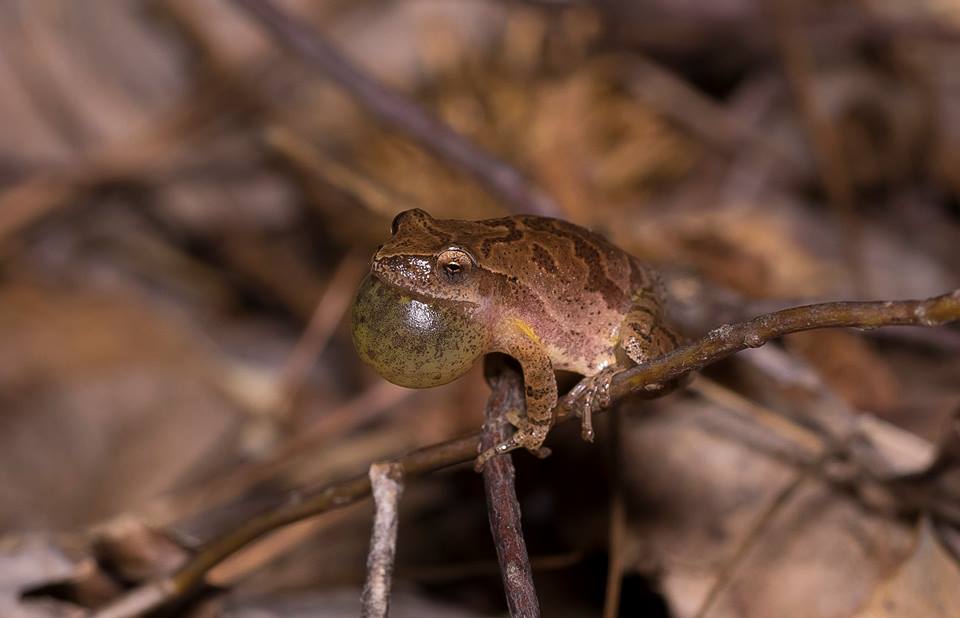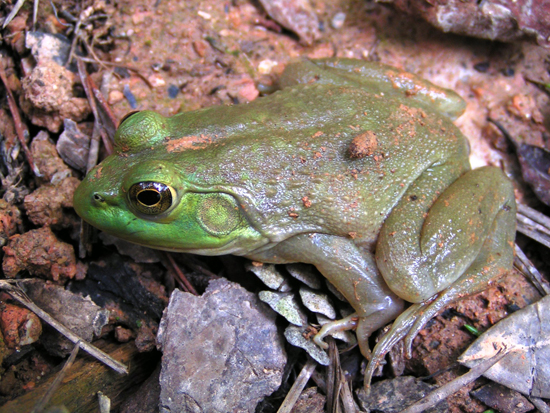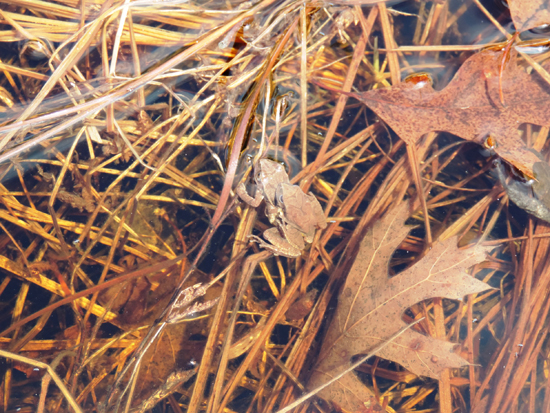We’re so pleased that Marlene A. Condon offered to share her expertise about creating wildlife-friendly gardens and backyards. Marlene is a nature writer and photographer with a passion for creating wildlife habitat around homes. A field editor for Birds & Blooms since the magazine’s debut in 1995, she has been published in numerous newspapers and magazines and is the author of The Nature-Friendly Garden: Creating a Backyard Haven for Wildlife, Plants, and People (Stackpole Books).
With fall upon us, the majority of gardeners are thinking about cleaning up the garden and putting it “to bed.” But this year, leave the garden alone. Numerous kinds of wildlife are getting ready for winter. Your hands-off attitude in autumn will benefit them and they will repay you next year when you begin a new gardening season.

Japanese Maple with its leaves raked around it to provide hibernation cover for numerous kinds of wildlife, including tree frogs.
The falling leaves that pile up along your garden fence create a haven where Gray Treefrogs and Spring Peepers can hibernate. Next spring, as temperatures rise and these two kinds of treefrogs awaken, they will climb up into your trees and shrubs to feed upon insects and spiders. Peepers, which usually stay within two to three feet from the ground, might also be found on your herbaceous (non-woody) plants. But no matter where they feed, these amphibians help to limit the populations of invertebrates to numbers that your plants can sustain without incurring serious harm.
Some species of spiders and insects are taking refuge within your dying and drying garden plants to try to survive the winter in an inactive adult state. Other species will soon perish, leaving behind eggs, larvae, or pupae on or within plants to carry on the line—if they survive the searching eyes of numerous predators still active in cold weather.

Praying Mantid egg mass on Purple Ruffled Basil. Dried plant stalks contain the eggs of numerous critters essential to the functioning of the garden.
Watch your garden throughout the winter and you will see birds, such as Downy Woodpeckers and Carolina Chickadees, clinging to and poking your brown plants. They are looking for the tiny insects and spiders, in whatever form, that provide our avian creatures with the fat and protein they require to survive the harshest time of the year.

American Goldfinches feeding in winter on Purple Ruffled Basil seeds.
If there are plants and food aplenty during the winter for them, birds that are permanent residents of the area may want to build nests next spring in your yard. As winter comes to an end, you simply need to cut up the old plant stalks a bit and let them lie where they fall. Many kinds of birds, such as Carolina Wrens, need such old stems, along with those dried leaves that sheltered the treefrogs, to construct their nests.

Carolina Wren chicks leaving nest made of plant debris.
The dried plant material that the birds don’t take will be recycled into the soil for the benefit of your growing plants. As snails and slugs become active, they will be delighted to find their favorite food (decaying plant and animal matter) waiting for them to feed upon. When these unusual organisms are provided with such a fine smorgasbord, they don’t bother your growing plants. Instead, they help to fertilize them—which is exactly what their function in your garden is supposed to be.

Snails feeding on plant debris and sickly plant that need to be recycled.
In other words, when you allow natural processes to occur as they are meant to happen, you don’t bring about the problems that most gardeners assume they are destined to encounter. As numerous kinds of wildlife go about their everyday activities in your yard, they limit populations of other kinds of wildlife, thus eliminating overpopulations that are usually the sources of people’s gardening difficulties.
By creating a nature-friendly garden, you save money, time, and effort by not needing chemical pesticides. By avoiding the use of pesticides, you don’t interfere with “Mother Nature’s” system of checks and balances that exists to keep the environment functioning properly.
You also don’t inadvertently harm wildlife that is not injurious to your plants. Any insects or spiders poisoned by pesticides are easy prey for all of the other kinds of animals that feed upon them which means those critters can be poisoned as well. And plants sprayed with herbicides pose an extreme danger to our helpful insect-eating amphibians, such as salamanders and toads, which have very absorbent skin.
Therefore, to avoid garden problems, help wildlife to survive in your yard. You’ll get to enjoy the lovely songs and beauty of birds, the sights and sounds of numerous kinds of wildlife, and a more relaxed and thus more satisfying manner of gardening.
Please visit Marlene’s website to learn more about her information- and photo-packed book.

All photographs copyright Marlene A. Condon

















